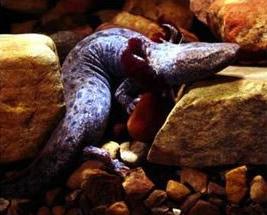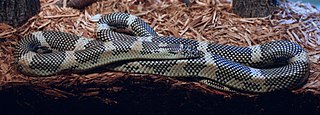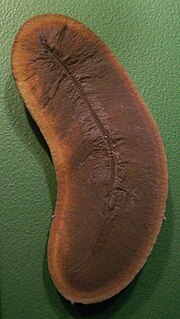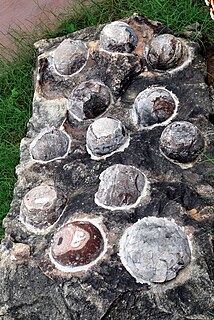
The Carboniferous is a geologic period and system that spans 60 million years from the end of the Devonian Period 358.9 million years ago (Mya), to the beginning of the Permian Period, 298.9 Mya. The name Carboniferous means "coal-bearing" and derives from the Latin words carbō ("coal") and ferō, and was coined by geologists William Conybeare and William Phillips in 1822.

Amniotes are a clade of tetrapod vertebrates comprising the reptiles, and mammals. Amniotes lay their eggs on land or retain the fertilized egg within the mother, and are distinguished from the anamniotes, which typically lay their eggs in water. Older sources, particularly prior to the 20th century, may refer to amniotes as "higher vertebrates" and anamniotes as "lower vertebrates", based on the discredited idea of the evolutionary great chain of being.

Tullimonstrum, colloquially known as the Tully Monster, is an extinct genus of soft-bodied bilaterian that lived in shallow tropical coastal waters of muddy estuaries during the Pennsylvanian geological period, about 300 million years ago. A single species, T. gregarium, is known. Examples of Tullimonstrum have been found only in the Mazon Creek fossil beds of Illinois, United States. Its classification has been the subject of controversy, and interpretations of the fossil have likened it to molluscs, arthropods, conodonts, worms, and vertebrates.

The egg is the organic vessel containing the zygote in which an embryo develops until it can survive on its own, at which point the animal hatches. An egg results from fertilization of an egg cell. Most arthropods, vertebrates, and mollusks lay eggs, although some, such as scorpions, do not.

The common mudpuppy is a species of salamander in the genus Necturus. They live an entirely aquatic lifestyle in the eastern part of North America in lakes, rivers, and ponds. They go through paedomorphosis and retain their external gills. Because skin and lung respiration alone is not sufficient for gas exchange, mudpuppies must rely on external gills as their primary means of gas exchange. They are usually a rusty brown color and can grow to an average length of 33 cm (13 in). Mudpuppies are nocturnal creatures, and come out during the day only if the water in which they live is murky. Their diet consists of almost anything they can get in their mouths, including insects, mollusks, and earthworms. Once a female mudpuppy reaches sexual maturity at six years of age, she can lay an average of 60 eggs. In the wild, the average lifespan of a mudpuppy is 11 years.

The Mazon Creek fossil beds are a conservation lagerstätte found near Morris, in Grundy County, Illinois. The fossils are preserved in ironstone concretions, formed approximately 309 million years ago in the mid-Pennsylvanian epoch of the Carboniferous period. These concretions frequently preserve both hard and soft tissues of animal and plant materials, as well as many soft-bodied organisms that do not normally fossilize. The quality, quantity and diversity of fossils in the area, known since the mid-nineteenth century, make the Mazon Creek lagerstätte important to paleontologists, in attempting to reconstruct the paleoecology of the sites. The locality was declared a National Historic Landmark in 1997.

Diadectomorpha are a clade of large tetrapods that lived in Euramerica during the Carboniferous and Early Permian periods and in Asia during Late Permian (Wuchiapingian), They have typically been classified as advanced reptiliomorphs close to the ancestry of the Amniota, though some paleontologists consider them basal synapsids. They include both large carnivorous and even larger herbivorous forms, some semi-aquatic and others fully terrestrial. The Diadectomorpha seem to have evolved during late Mississippian times, although they only became common after the Carboniferous rainforest collapse and flourished during the Late Pennsylvanian and Early Permian periods.

Doryteuthis opalescens, the opalescent inshore squid is a small squid in the family Loliginidae. It is a myopsid squid, which is the near shore group and that means that they have corneas over their eyes. The species lives in the eastern Pacific Ocean from Mexico's Baja California peninsula to Alaska, United States, and as an inshore squid it can be found with a range of 200 miles (320 km) off the coast.

Pohlsepia mazonensis is the earliest described octopod, originating from the late Carboniferous period. The species is known from a single exceptionally preserved fossil discovered in the Pennsylvanian Francis Creek Shale of the Carbondale Formation, north-east Illinois, United States.

The Mediterranean painted frog or simply painted frog, Discoglossus pictus, is a species of frog in the family Alytidae.

Belemnotheutis is an extinct coleoid cephalopod genus from the middle and upper Jurassic, related to but morphologically distinct from belemnites. Belemnotheutis fossils are some of the best preserved among coleoids. Remains of soft tissue are well-documented in some specimens, even down to microscopic muscle tissue. In 2008, a group of paleontologists even recovered viable ink from ink sacs found in several specimens.

The Apalachicola kingsnake is a non-venomous species of kingsnake found in a small area of the Florida panhandle known as the Apalachicola Lowlands. Long argued as to whether or not it is a subspecies, the Apalachicola kingsnake was formerly named Lampropeltis getula goini. After years of research and many more specimens examined, in 2006 it was renamed to Lampropeltis getula meansi after D. Bruce Means, in recognition of his work on this subspecies.

Pseudophlegethontia is an extinct genus of aïstopod lepospondyl. It is the only member of the family Pseudophlegethontiidae. The only species is the type species P. turnbullorum, named in 2003. Fossils of Pseudophlegethontia have been found from the Mazon Creek fossil beds in Grundy County, Illinois, a conservation lagerstätte well known for the exceptional preservation of middle Pennsylvanian taxa.

Paleontology in Illinois refers to paleontological research occurring within or conducted by people from the U.S. state of Illinois. Scientists have found that Illinois was covered by a sea during the Paleozoic Era. Over time this sea was inhabited by animals including brachiopods, clams, corals, crinoids, sea snails, sponges, and trilobites.

Egg fossils are the fossilized remains of eggs laid by ancient animals. As evidence of the physiological processes of an animal, egg fossils are considered a type of trace fossil. Under rare circumstances a fossil egg may preserve the remains of the once-developing embryo inside, in which case it also contains body fossils. A wide variety of different animal groups laid eggs that are now preserved in the fossil record beginning in the Paleozoic. Examples include invertebrates like ammonoids as well as vertebrates like fishes, possible amphibians, and reptiles. The latter group includes the many dinosaur eggs that have been recovered from Mesozoic strata. Since the organism responsible for laying any given egg fossil is frequently unknown, scientists classify eggs using a parallel system of taxonomy separate from but modeled after the Linnaean system. This "parataxonomy" is called veterovata.

Cephalopod egg fossils are the fossilized remains of eggs laid by cephalopods. The fossil record of cephalopod eggs is scant since their soft, gelatinous eggs decompose quickly and have little chance to fossilize. Eggs laid by ammonoids are the best known and only a few putative examples of these have been discovered. The best preserved of these were discovered in the Jurassic Kimmeridge Clay of England. Currently no belemnoid egg fossils have ever been discovered although this may be because scientists have not properly searched for them rather than an actual absence from the fossil record.
Fish egg fossils are the fossilized remains of fish eggs. Fossil fish eggs have an extensive record going at least as far back as the Devonian and spanning into the Cenozoic era. The eggs of many different fish taxa have contributed to this record, including lobe-finned fish, placoderms, and sharks. Occasionally eggs are preserved still within the mother's body, or associated with fossil embryos. Some fossil eggs possibly laid by fish cannot be confidently distinguished from those laid by amphibians; for example, the ichnogenus Mazonova is known from impressions of eggs which resemble eggs of both fish and amphibians. Paleontologist B.K. Hall has observed that the discovery of fossil fish eggs, embryos and larvae link the sciences of paleontology with evo-devo.

Macroneuropteris is a genus of Carboniferous seed plants in the order Medullosales. The genus is best known for the species Macroneuropteris scheuchzeri, a medium-size tree that was common throughout the late Carboniferous Euramerica. Three similar species, M. macrophylla, M. britannica and M. subauriculata are also included in the genus.
Etacystis communis, colloquially known as the H-animal or aitch, was a soft-bodied invertebrate that lived in shallow tropical coastal waters of muddy estuaries during the Pennsylvanian geological period, about 300 million years ago. The classification is uncertain: the animal had a unique H-shaped body ranging from 2 to 11 cm long, and researchers have suggested a hemichordate or hydrozoan affinity. Examples of Etacystis have been found only in the Mazon Creek fossil beds of the Midwestern United States.

Bandringa is an extinct genus of Elasmobranch known from the Pennsylvanian subperiod of the Carboniferous period. There is currently a single known species, B. rayi. It is known from exceptionally preserved individuals found in the Mazon Creek Lagerstätte of Illinois which dates back to the late Moscovian stage. Two species from this genus were originally described, B. rayi and B. herdinae, but the differences between the two were found to be taphonomic in origin. All Mazon Creek individuals appear to represent juveniles, suggesting the area was a nursery for them. Also supporting this notion are fossilized egg cases found in the same localities, though it is unclear whether they belong to this genus. Adult fossils attributed to B. rayi have also been found in Five Points, Ohio and Cannelton, Pennsylvania, both of which contain the roughly contemporaneous Kittaning Formation of the Allegheny Group. This species has a long rostrum and may have been analogous to modern sawfish. It appears to have fed via suction feeding. Preserved gut contents include articulated arthropods. Its relationships to other elasmobranchs is currently unclear.

















